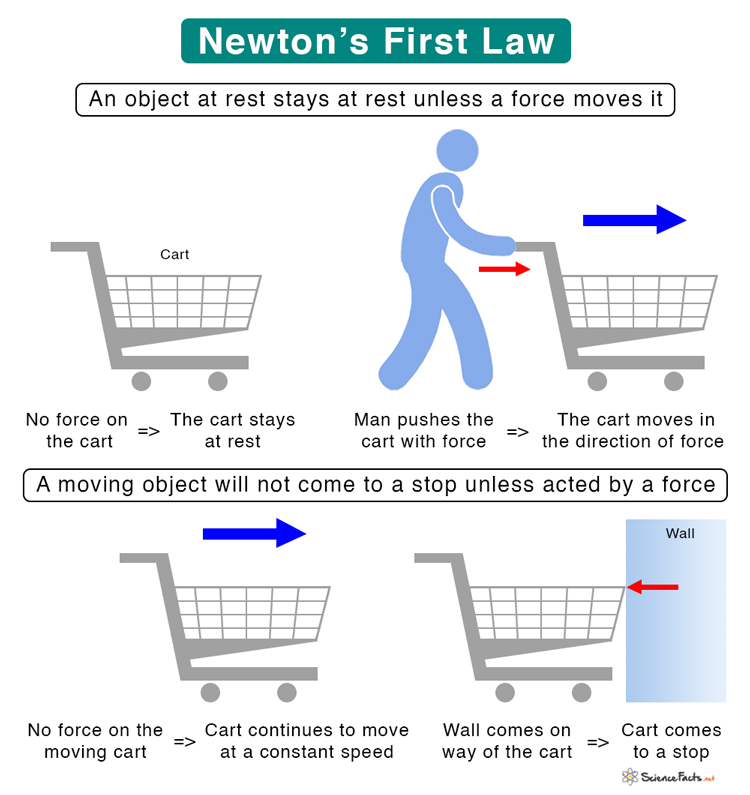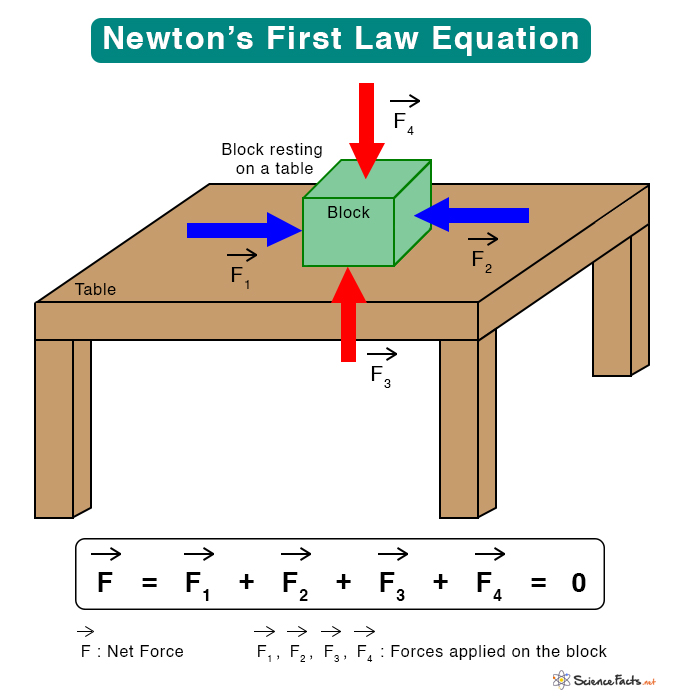Newton’s First Law
What is Newton’s First Law
Newton’s first law states that “An object at rest stays at rest, and object in motion stays at a constant speed and in a straight line unless acted upon by force”.
There are two parts to this law. One part predicts the behavior of an object at rest, and the other part predicts when it is moving. According to Newton’s first law,
- An object at rest cannot move unless there is a force to make it move.
- An object moving at a constant speed cannot come to a stop or change its speed or direction unless acted by force.
The force acting on the object is external and unbalanced. A balanced force does not affect the motion of the object. The image below shows a shopping cart at rest and in motion.
The importance of Newton’s first law is that it explains how objects move and how forces affect their motion. For example, a soccer ball stays at rest unless a player kicks it with force. The moving ball will not stop unless another player’s foot comes in the way or the goalkeeper catches it.
Why is Newton’s First Law Called the Law of Inertia
Another name for Newton’s first law is the law of inertia. The reason is that inertia is the property of an object to remain at rest or continue at a constant speed and direction. For example, a moving car comes to a sudden stop. The passengers in a car suddenly hustle forward. It is because the passengers were in the inertia of motion until the car came to a stop. For this reason, seat belts are advised inside a moving car.
Mass is another property that measures an object’s inertia. An object with more mass has more inertia and is challenging to move or bring to a stop. For example, it is easier to move a basketball than a large rock because the former has more mass than the latter.
Newton’s First Law Examples and Applications
When an Object is Stationary
1. Book Lying on a Table
A book lying motionless on a table has two forces acting on it – i. Force due to gravity, known as weight, and ii. Normal force. However, both these forces balance each other such that there is no unbalanced force acting on the book. It is for this reason that the book remains still.
2. Astronauts in Space
Astronauts feel weightlessness in space because they are far from the influence of Earth’s gravity. Now, consider astronauts in the International Space Station. The ISS rotates around the Earth such that its centripetal force balances the Earth’s gravitational force. As the forces are balanced, astronauts inside it feel weightless.
When an Object is Moving
1. Car
A car moving on a road at a constant speed comes to a stop upon braking. The brake stops the rotation of the wheels. Friction between the wheels and the road develops and stops the car.
2. Balloon
A balloon moving in a straight line will continue to move in the same direction unless the wind sweeps it and changes its direction. Here, the wind is the force responsible for changing the balloon’s direction. The balloon can come to a stop if it is stuck in a tree. The tree applies the force necessary to cease the balloon’s motion.
3. Spacecraft
Consider a spacecraft that has been launched into space. After the last booster is exhausted, the spacecraft drifts into interstellar space on its own at a constant velocity. The reason is that it is not under the influence of any other planet’s gravitational force and does not feel any force. Suppose it approaches a planet. Then, the planet’s gravitational force will change the spacecraft’s course, resulting in a change in its speed and direction.
Newton’s First Law Equation
Suppose several forces are acting on an object. They are vectorially represented by
According to the first law, the net force on the object is zero.
This equation also implies that the velocity v is constant.
v = constant
The image above shows Newton’s first law equation by taking the example of a block subject to forces.
-
References
Article was last reviewed on Saturday, September 30, 2023







